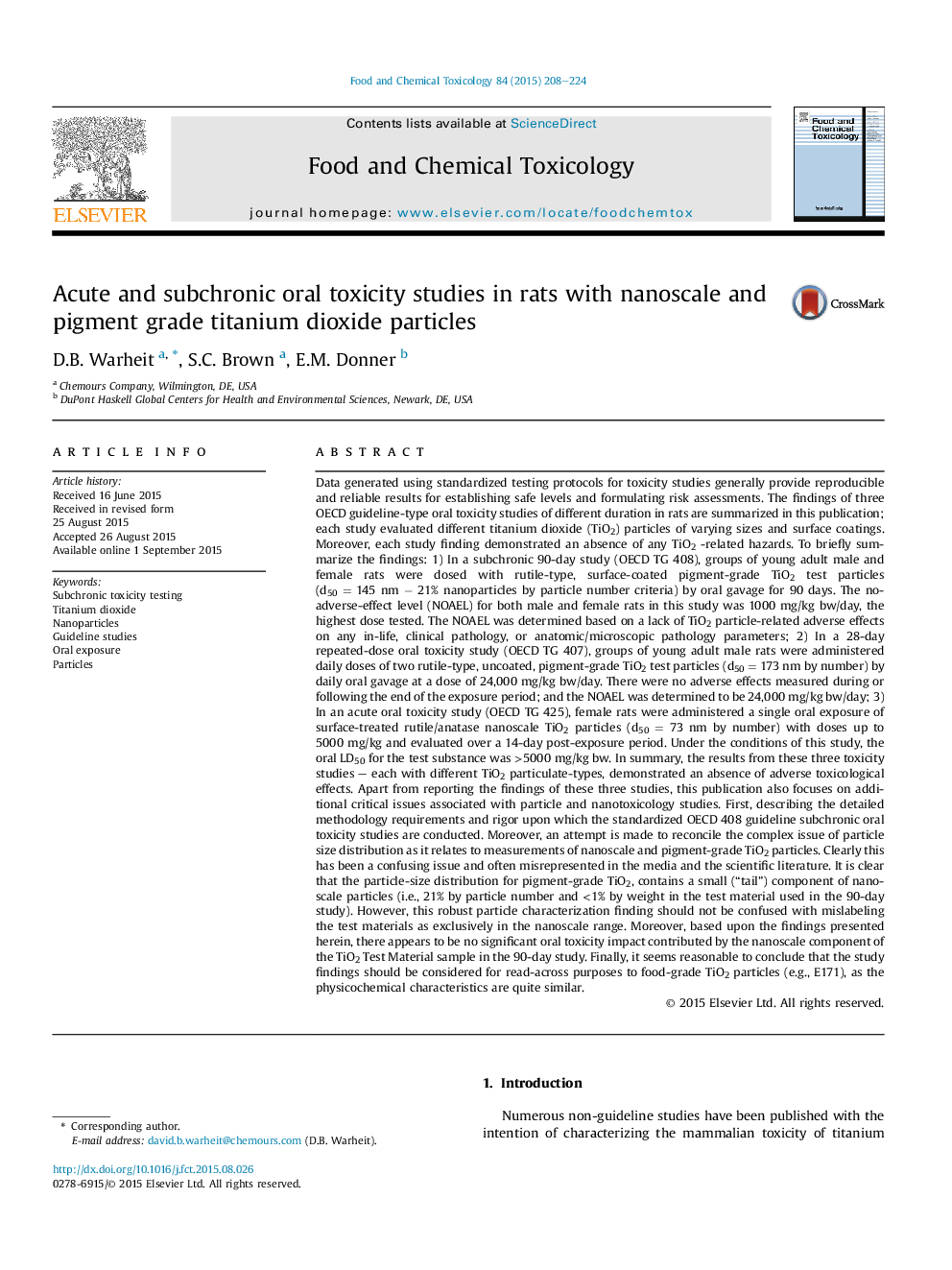| کد مقاله | کد نشریه | سال انتشار | مقاله انگلیسی | نسخه تمام متن |
|---|---|---|---|---|
| 5849537 | 1561760 | 2015 | 17 صفحه PDF | دانلود رایگان |
- Absence of adverse effects in 3 oral toxicity studies in rats with TiO2 particles.
- NOAEL for rats exposed orally for 90-days to pigmentary TiO2 was >1000Â mg/kg bw/day.
- Robust analysis of pigment TiO2 particles reveals a small component of nanoparticles.
- OECD test guidelines provide reliable, transparent and reproducible study results.
- Confusion exists in methodologies for properly characterizing TiO2 particle size.
Data generated using standardized testing protocols for toxicity studies generally provide reproducible and reliable results for establishing safe levels and formulating risk assessments. The findings of three OECD guideline-type oral toxicity studies of different duration in rats are summarized in this publication; each study evaluated different titanium dioxide (TiO2) particles of varying sizes and surface coatings. Moreover, each study finding demonstrated an absence of any TiO2 -related hazards. To briefly summarize the findings: 1) In a subchronic 90-day study (OECD TG 408), groups of young adult male and female rats were dosed with rutile-type, surface-coated pigment-grade TiO2 test particles (d50 = 145 nm â 21% nanoparticles by particle number criteria) by oral gavage for 90 days. The no-adverse-effect level (NOAEL) for both male and female rats in this study was 1000 mg/kg bw/day, the highest dose tested. The NOAEL was determined based on a lack of TiO2 particle-related adverse effects on any in-life, clinical pathology, or anatomic/microscopic pathology parameters; 2) In a 28-day repeated-dose oral toxicity study (OECD TG 407), groups of young adult male rats were administered daily doses of two rutile-type, uncoated, pigment-grade TiO2 test particles (d50 = 173 nm by number) by daily oral gavage at a dose of 24,000 mg/kg bw/day. There were no adverse effects measured during or following the end of the exposure period; and the NOAEL was determined to be 24,000 mg/kg bw/day; 3) In an acute oral toxicity study (OECD TG 425), female rats were administered a single oral exposure of surface-treated rutile/anatase nanoscale TiO2 particles (d50 = 73 nm by number) with doses up to 5000 mg/kg and evaluated over a 14-day post-exposure period. Under the conditions of this study, the oral LD50 for the test substance was >5000 mg/kg bw. In summary, the results from these three toxicity studies - each with different TiO2 particulate-types, demonstrated an absence of adverse toxicological effects. Apart from reporting the findings of these three studies, this publication also focuses on additional critical issues associated with particle and nanotoxicology studies. First, describing the detailed methodology requirements and rigor upon which the standardized OECD 408 guideline subchronic oral toxicity studies are conducted. Moreover, an attempt is made to reconcile the complex issue of particle size distribution as it relates to measurements of nanoscale and pigment-grade TiO2 particles. Clearly this has been a confusing issue and often misrepresented in the media and the scientific literature. It is clear that the particle-size distribution for pigment-grade TiO2, contains a small (“tail”) component of nanoscale particles (i.e., 21% by particle number and <1% by weight in the test material used in the 90-day study). However, this robust particle characterization finding should not be confused with mislabeling the test materials as exclusively in the nanoscale range. Moreover, based upon the findings presented herein, there appears to be no significant oral toxicity impact contributed by the nanoscale component of the TiO2 Test Material sample in the 90-day study. Finally, it seems reasonable to conclude that the study findings should be considered for read-across purposes to food-grade TiO2 particles (e.g., E171), as the physicochemical characteristics are quite similar.
Journal: Food and Chemical Toxicology - Volume 84, October 2015, Pages 208-224
